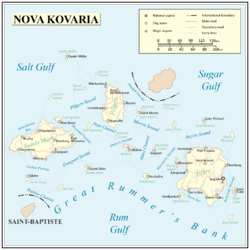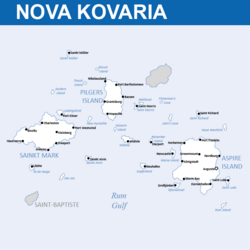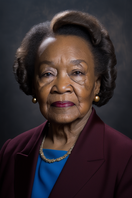Nova Kovaria: Difference between revisions
Ozycaevias (talk | contribs) No edit summary |
Ozycaevias (talk | contribs) No edit summary |
||
| Line 107: | Line 107: | ||
==Government and Politics== | ==Government and Politics== | ||
{{Main|Politics of Nova Kovaria}} | {{Main|Politics of Nova Kovaria}} | ||
{ | {{Prime Minister and President of Nova Kovaria}} | ||
Nova Kovaria is a {{wp|Representative_democracy|representative democratic}} republic with a {{wp|Unitary_state|unitary}} {{wp|Parliamentary_system|parliamentary}} system of government. The Constitution of 1921 established the current political system. The legislative branch of the government, the [[Politics_of_Nova_Kovaria#Parliament|Nova Kovarian Parliament]], is a {{wp|Bicameralism|bicameral}} body consisting of the {{wp|upper house}}, the 25-member [[Politics_of_Nova_Kovaria#Assembly|Assembly]], and the {{wp|lower house}}, the 120-member [[Politics_of_Nova_Kovaria#Senate|Senate]]. As prescribed by the Constitution, members of the Assembly are directly elected by the people through {{wp|instant-runoff voting}}, while Senate seats are awarded through {{wp|party-list proportional representation}}. There is a 1% {{wp|electoral threshold}} for parties to receive representation in the Senate. | Nova Kovaria is a {{wp|Representative_democracy|representative democratic}} republic with a {{wp|Unitary_state|unitary}} {{wp|Parliamentary_system|parliamentary}} system of government. The Constitution of 1921 established the current political system. The legislative branch of the government, the [[Politics_of_Nova_Kovaria#Parliament|Nova Kovarian Parliament]], is a {{wp|Bicameralism|bicameral}} body consisting of the {{wp|upper house}}, the 25-member [[Politics_of_Nova_Kovaria#Assembly|Assembly]], and the {{wp|lower house}}, the 120-member [[Politics_of_Nova_Kovaria#Senate|Senate]]. As prescribed by the Constitution, members of the Assembly are directly elected by the people through {{wp|instant-runoff voting}}, while Senate seats are awarded through {{wp|party-list proportional representation}}. There is a 1% {{wp|electoral threshold}} for parties to receive representation in the Senate. | ||
Revision as of 18:04, 11 July 2023
This article is incomplete because it is pending further input from participants, or it is a work-in-progress by one author. Please comment on this article's talk page to share your input, comments and questions. Note: To contribute to this article, you may need to seek help from the author(s) of this page. |
Republic of Nova Kovaria Republik Niuwekovår (Tyrnican) | |
|---|---|
| Motto: "Quaerere novos prospectus" "Seek new horizons" | |
| Anthem: Upward Kovaria! Aufwärts Kovår! | |
 Atlas of Nova Kovaria | |
 Map of Nova Kovaria | |
| Capital | Augusta |
| Largest city | Freeport |
| Official languages | Rythenean, Tyrnican |
| Recognised national languages | Principean |
| Recognised regional languages | Baptistois Creole |
| Demonym(s) | Nova Kovarian or Kovarian |
| Government | Unitary parliamentary republic |
| Jonas Granger | |
| Laura Pastor | |
| Legislature | Parliament |
| Assembly | |
| Senate | |
| Establishment | |
• Governorship of Nova Kovaria | 9 May 1799 |
• First Nova Kovarian Republic | 30 September 1868 |
• August Revolution | 10 June 1921 |
| Area | |
• Total | 18,778.46 km2 (7,250.40 sq mi) |
• Water (%) | negligeble |
| Population | |
• 2020 census | 6,756,433 |
• Density | 359.79/km2 (931.9/sq mi) |
| GDP (PPP) | 2020 estimate |
• Total | $313.059 billion |
• Per capita | $46,338 |
| GDP (nominal) | 2020 estimate |
• Total | $331.226 billion |
• Per capita | $49,027 |
| Gini (2020) | medium |
| HDI (2020) | very high |
| Currency | Nova Kovarian Note (₦) (NKN) |
| Date format | dd-mm-yyyy |
| Driving side | left |
| Calling code | +19 |
| ISO 3166 code | NKV |
| Internet TLD | .nk |
Nova Koravia (Tyrnican: Niuwekovår), officially the Republic of Nova Kovaria (Republik Niuwekovår) is an island country located in the Rum Gulf. Its closest neighbor is Saint-Baptiste, with whom it shares the Rum Islands archipelago. It has a population of 6,756,433 people spread across 3 major and numerous minor islands. Its capital is Augusta on Aspire Island and its largest city is Freeport on Sainkt Mark.
Home to native peoples since at least the 1st century, Tyrnican and Rythenean settlers arrived in the early-mid 17th century, haphazardly establishing settlements across the archipelago. Chattel slaves (from Idica) and indentured servants (from Auressia and, to a lesser extent, Surucia) arrived soon after. These institutions would result in a boom of cash crop and monocultural plantation farming, including sugar, coffee, and fruits. By the late 17th century, almost all of the native population had died from disease or deliberate attacks by the settlers.
Cooperation emerged between the Tyrnican and Rythene populations, forming a distinct Nova Koravian identity. During the Tyrno-Rythenean Wars, the Rythenean controlled islands were taken and the archipelago was reorganized under the single Governor of Nova Kovaria. Tyrnican rule would last until 1854 when the islands were traded to Audonia for a long-term partnership. Turmoil in Aurdonia and unrest in the islands, however, would lead to independence in 1868 as the First Republic of Nova Kovaria. This republic would eventually fall to a coup in the late 1880’s before being restored during the August Revolution in 1921.
Nova Kovaria is a developed nation and has a broad manufacturing sector, including high-tech, petrochemical, pharmaceutical, and industrial machinery industries. It also retains robust financial and service sectors, as well as an emerging spaceflight industry. Tourism is also a large industry, though it is highly localized and often not the focus of the nation. For the most part, agriculture has been superseded by manufacturing, and much of the islands’ food is imported. A lack of other natural resources has created a deficit to import the raw materials and basic goods needed for Nova Kovaria’s manufacturing. Fossil fuels, especially, are a significant portion of its international trade.
Etymology
The name "Nova Kovaria" is a Latinization of "New Kovaar" and is the recognized Rythenean-language name for the nation. In Tyrnican the name is "Niuwekovår" which is a direct translation of "New Kovaar". The nation's name originally came from the charter establishing the Governorship of Nova Kovaria, which named the colony after old Kovaar in Tyrnica. Some uncertainty exists as to whether the name predates the charter, with some older documents referring to the region as "Nova Kovaar", "Ruminselien", and "Friedericksland".
There exists a contemporary movement to rename the country as part of a broader effort to decolonialize it. Some proposed alternatives include Aspire (from Aspire Island), Halcyon, and Goldshore. This movement has, thus far, seen limited success and is widely considered a fringe movement.
History
With the breakout of the Tea War, further unrest related to the solidification of the Nova Kovarian identity, and an increasing desire by Tyrnica to lure Audonia into a partnership, the Kovarian Agreement was signed in 1854. This agreement transferred the ownership of Nova Kovaria to Audonia in exchange for assistance in future conflicts.
As part of its independence, a series of asymetrical treaties, known collectively as the Audonian-Kovarian Accords, were imposed on Nova Kovaria by Audonia under the guise of protecting the new country from Albrennian influence. This included a number of requirements and stipulations on Nova Kovaria, including a permanent Audonian naval base on Pilger's Island, Audonian oversight on trade and diplomatic agreements, and a mandatory consultation and first-offer role for any new industrial ventures. Audonia also reserved the right of intervention in Nova Kovaria if it believed it necessary, either politically or militarily. These treaties, broadly unpopular in Nova Kovaria, would be subsequently dismantled and renegotiated under Audonia's 'Good Neighbor' policy between 1890 and 1950.
During the First Great War, Nova Kovaria maintained strict neutrality in an effort to appease both of its ethnic Rytheneans and Tyrnicans. This was made difficult due to pressure from Audonia, eventually culminating in the back-room utilization of the Audonian-Kovarian Accords by Audonia to send funds to the Galene League through Nova Kovaria's banks. This funneling of money would not be revealed until 2006.
Government and Politics

|

|
| Jonas Granger Prime Minister |
Laura Pastor President |
Nova Kovaria is a representative democratic republic with a unitary parliamentary system of government. The Constitution of 1921 established the current political system. The legislative branch of the government, the Nova Kovarian Parliament, is a bicameral body consisting of the upper house, the 25-member Assembly, and the lower house, the 120-member Senate. As prescribed by the Constitution, members of the Assembly are directly elected by the people through instant-runoff voting, while Senate seats are awarded through party-list proportional representation. There is a 1% electoral threshold for parties to receive representation in the Senate.
| Group | Party leader | Seats | % of seats | ||||
|---|---|---|---|---|---|---|---|
| ▌National Liberal | Jonas Granger | 54 | 45% | ||||
| ▌Democratic | Warren Eckhart | 31 | 25.8% | ||||
| ▌Social Sustainment | 16 | 13.3% | |||||
| ▌Kovaria Forward | 6 | 5% | |||||
| ▌Progressive | 4 | 3.3% | |||||
| ▌Leftist Union | 2 | 1.7% | |||||
| ▌Niuwekovårpartei[a] | 1 | 0.8% | |||||
| ▌Aspyre Anticolonialist | 1 | 0.8% | |||||
| ▌Independents | 5 | 4.2% | |||||
| ▌Vacant[b] | 2 | 1.7% | |||||
| Total | 120 | 100.0% | |||||
|
Bolded parties are part of the current government. Notes:
| |||||||
Assembly members serve staggered 8-year terms, with half of the Assembly up for election every 4 years. Since 1967, Assembly members have been restricted to two terms in office. The Senate is nominally scheduled to hold elections every 4 years after a previous Senate election. However, the government can be dissolved early by a no-confidence vote by the Senate or a dissolution motion by the Assembly signed by the President.
The President is the head of state and is elected directly by instant-runoff voting for a 6-year term, with no term limit. The role of the president is mainly ceremonial, though they have the power to call for a referendum with a majority vote in the Assembly. The Prime Minister is the head of government and is appointed by a majority of the Senate. Cabinet ministers, who are appointed by the Senate, form the executive body together with the Prime Minister. The President and Prime Minister are currently Laura Pastor and Jonas Granger, respectively.
The highest judicial body in Nova Kovaria is the Constitutional Court, which has explicit judicial review power provided by the Constitution. The court is composed of five justices appointed by the Assembly for a single term of 18 years. The court's agenda is determined by the Chief Justice, a position rotated between the serving justices once a year.
Economy
Nova Kovaria is a country with a highly developed market economy that is centered around manufacturing, services, and high-tech industry. The country is known for its production of high-quality goods and is home to several well-known Kovarian brands and companies, including Apollo Computers and KM Pharmaceuticals. These companies have earned a reputation for their excellence in producing high-quality products.
Nova Kovaria has a well-developed manufacturing sector that includes high-tech, petrochemical, pharmaceutical, and industrial machinery industries. The country is also known for its robust financial and service sectors, which contribute significantly to the nation's economy. The country's emerging spaceflight industry is also gaining international recognition, with both public and private organizations investing in the sector.
Investment in science and technology is a top priority for Nova Kovaria, which has resulted in the nation's international reputation for software development, communication, engineering, and other areas of research. The country is home to several research and development centers, including the Kovarian Aerospace and Astronautics Bureau (KAAB) and the Kovarian Institute of Technology, which are dedicated to advancing the nation's technological capabilities.
The currency of Nova Kovaria is the Nova Kovarian Note (NKN or ₦), which is issued by the Central Kovarian Reserve Authority (CKRA). The CKRA is responsible for maintaining the stability of the country's financial system by setting monetary policy, regulating banks, and ensuring the smooth functioning of the economy. The Nova Kovarian Note is widely used throughout the Rum Gulf, and its exchange rate is closely monitored by the CKRA to ensure economic stability.

